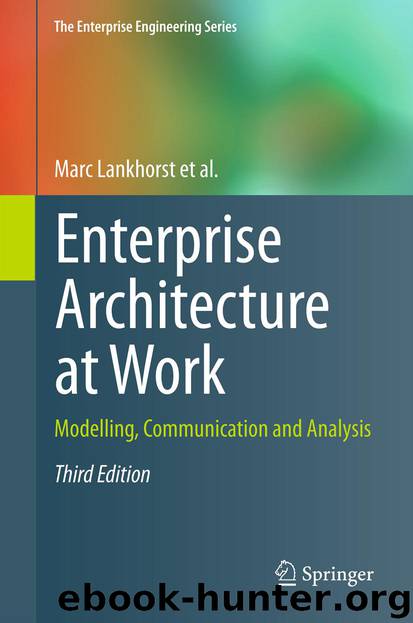Enterprise Architecture at Work by Marc Lankhorst

Author:Marc Lankhorst
Language: eng
Format: epub
Publisher: Springer Berlin Heidelberg, Berlin, Heidelberg
7.1.1 Origin of Viewpoints
The concept of viewpoint is not new. For example, in the mid 1980s, Multiview (Wood-Harper et al. 1985) already introduced the notion of views. In fact, Multiview identified five viewpoints for the development of (computerised) information systems: Human Activity System, Information Modelling, Socio-Technical System, Human–Computer Interface, and the Technical System. During the same period in which Multiview was developed, the so-called CRIS Task Group of IFIP Working Group 8.1 developed similar notions, where stakeholder views were reconciled via appropriate ‘representations’. Special attention was paid to disagreement about which aspect (or perspective) was to dominate the system design (namely, ‘process’, ‘data’, or ‘behaviour’). As a precursor to the notion of concern, the CRIS Task Group identified several human roles involved in information system development, such as executive responsible, development coordinator, business analyst, business designer (Olle et al. 1988).
The use of viewpoints is not limited to the information systems community, it was also introduced by the software engineering community. In the 1990s, a substantial number of software engineering researchers worked on what was phrased as ‘the multiple perspectives problem’ (Finkelstein et al. 1992; Kotonya and Sommerville 1992; Nuseibeh 1994; Reeves et al. 1995). By this term, the authors referred to the problem of how to organise and guide (software) development in a setting with many actors, using diverse representation schemes, having diverse domain knowledge, and using different development strategies. A general framework has been developed in order to address the diverse issues related to this problem (Finkelstein et al. 1992; Kotonya and Sommerville 1992; Nuseibeh 1994). In this framework, a viewpoint combines the notion of actor, role, or agent in the development process with the idea of a perspective or view which an actor maintains. A viewpoint is more than a partial specification; in addition, it contains partial knowledge of how further to develop that partial specification. These early ideas on viewpoint-oriented software engineering have found their way into the IEEE 1471 standard for architecture description (IEEE Computer Society 2000) on which we have based our definitions below.
Download
This site does not store any files on its server. We only index and link to content provided by other sites. Please contact the content providers to delete copyright contents if any and email us, we'll remove relevant links or contents immediately.
Deep Learning with Python by François Chollet(14614)
The Mikado Method by Ola Ellnestam Daniel Brolund(11865)
Hello! Python by Anthony Briggs(11788)
OCA Java SE 8 Programmer I Certification Guide by Mala Gupta(11240)
Dependency Injection in .NET by Mark Seemann(11000)
Algorithms of the Intelligent Web by Haralambos Marmanis;Dmitry Babenko(9831)
The Well-Grounded Java Developer by Benjamin J. Evans Martijn Verburg(9420)
Grails in Action by Glen Smith Peter Ledbrook(9162)
Secrets of the JavaScript Ninja by John Resig Bear Bibeault(8594)
Test-Driven iOS Development with Swift 4 by Dominik Hauser(8308)
Becoming a Dynamics 365 Finance and Supply Chain Solution Architect by Brent Dawson(7978)
Microservices with Go by Alexander Shuiskov(7747)
Practical Design Patterns for Java Developers by Miroslav Wengner(7637)
Test Automation Engineering Handbook by Manikandan Sambamurthy(7588)
Kotlin in Action by Dmitry Jemerov(7262)
Angular Projects - Third Edition by Aristeidis Bampakos(7070)
The Art of Crafting User Stories by The Art of Crafting User Stories(6519)
NetSuite for Consultants - Second Edition by Peter Ries(6454)
Demystifying Cryptography with OpenSSL 3.0 by Alexei Khlebnikov(6242)
